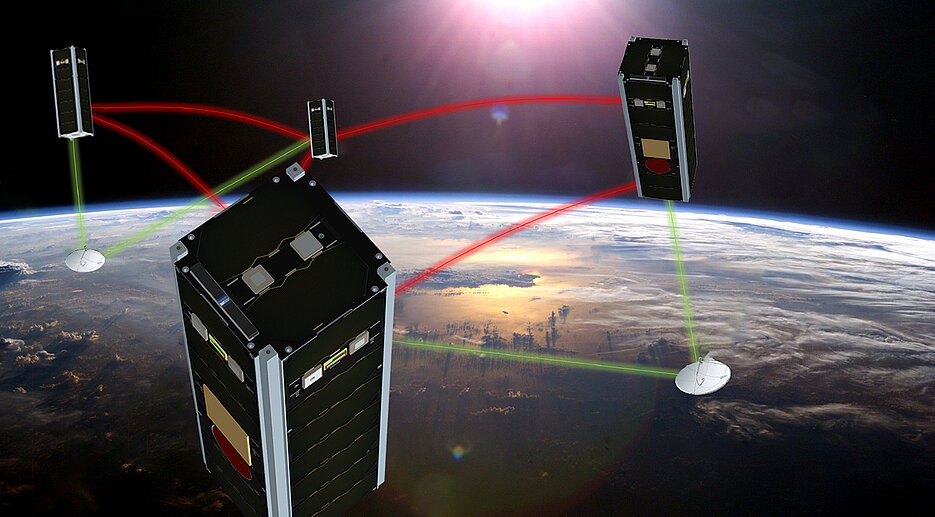Innovative Satellite-based Sensor Networks
05/26/2020Four nano-satellites from Würzburg are facing launch. They will fly demonstrate formation control in a three-dimensional configuration first time worldwide.

To survey an object such as Earth completely without blind spots, it has to be viewed from different angles and the image data has to be combined. The techniques required for optimal self-organisation of a satellite formation in three-dimensional space will now be tested for the first time using four nano-satellites.
"This will open up new perspectives for Earth observation and climate research as well as for future telecommunication systems," says Professor Klaus Schilling who heads the Chair of Informatics VII (Robotics and Telematics) at Julius-Maximilians-Universität (JMU) Würzburg in Bavaria, Germany. He and his team developed the satellites supported by the NetSat ERC Grant of the European Union.
Final touches at Zentrum für Telematik
Each of the four nano-satellites weighs just four kilogrammes. They are being fine-tuned at Zentrum für Telematik in Würzburg until the end of May 2020. The small satellites are scheduled to be launched into an orbit at an altitude of 600 kilometres by a Russian Soyuz rocket.
The long-term task planning will be performed by the control centre in Würzburg with the on-board software autonomously correcting deviations from schedule and precisely adjusting formation flying.
What's special about the nano-satellites
"Techniques for formation flight have only been tested with two satellites so far," Schilling explains. He hopes that NetSat will provide scientific breakthroughs in the control techniques required for a three-dimensional configuration to yield optimal observation results.
For this purpose, the satellites are equipped with a highly efficient electric propulsion system from Austrian manufacturer Enpulsion. Additionally, the satellites feature high-precision alignment functions using miniature reaction wheels made by S4 – Smart Small Satellite Systems and Wittenstein Cyber Motors.
The radio link between the satellites will enable data about position, alignment and planned manoeuvres to be exchanged between the satellites. "Combined with advanced control methods, this will allow us to coordinate the quadruplet," the JMU professor says.
Background of the NetSat mission
The NetSat mission was made possible by a prestigious grant of the European Research Council (ERC) and support from the Bavarian Ministry of Economic Affairs. In 2012, Professor Schilling received the EUR 2.5 million ERC Advanced Grant to make scientific breakthroughs in the field of control technology and space exploration.
The independent research institute "Zentrum für Telematik (ZfT)" in Würzburg was selected to implement NetSat because it operates one of Europe's leading test infrastructures for multi-satellite systems. The NetSat satellites are also used for experiments on multi-satellite operation at JMU.
Results will be used immediately
The NetSat results are directly incorporated in the next nano-satellite missions for innovative applications in Earth observation run by JMU:
TIM — Telematics International Mission: ZfT and JMU coordinate partners from five continents to implement an innovative 3D Earth observation system for volcanic eruptions, earthquakes and ship movements using nine satellites. The mission, which will start in 2021, is a collaborative project of the Regional Leaders Summit (RLS), a network comprised of the regions Bavaria, Upper Austria, Georgia (USA), Quebec (Canada), São Paulo (Brazil), Shandong (China) and Western Cape (South Africa).
https://www.rls-sciences.org/small-satellites.html
CloudCT: From 2022, ten self-organising nano-satellites will be used to characterise the interior of clouds using computer tomography methods to gather important parameters for climate models that have not been recorded yet. The European Research Council supports this project with a EUR 14 million ERC Synergy Grant. Research partners from Israel are involved in the project.
https://cordis.europa.eu/project/id/810370
"I am excited that this will allow us to further use the NetSat results," Schilling says. "The nano-satellite observation networks in orbit can rapidly provide a better basis for decision-making in emergency situations and for challenges such as climate change."
Contact
Prof. Dr. Klaus Schilling, Zentrum für Telematik, T +49 931 615-633-10, klaus.schilling@telematik-zentrum.de
Website of the NetSat project with videos and links to publications www.telematik-zentrum.de/netsat






